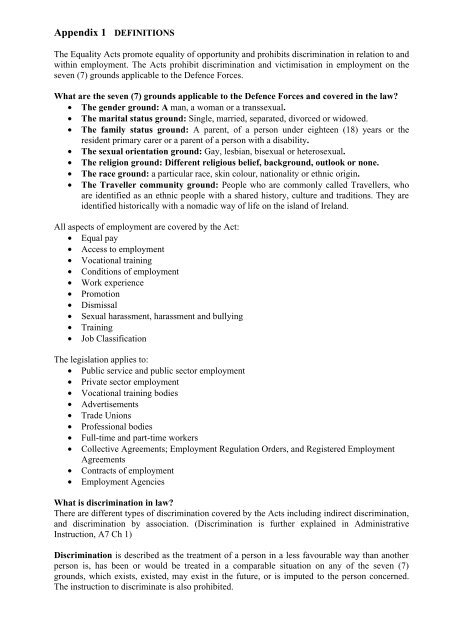Defence Forces Equality, Diversity, and Equal Status Policies 2007
Defence Forces Equality, Diversity, and Equal Status Policies 2007
Defence Forces Equality, Diversity, and Equal Status Policies 2007
You also want an ePaper? Increase the reach of your titles
YUMPU automatically turns print PDFs into web optimized ePapers that Google loves.
Appendix 1 DEFINITIONS<br />
The <strong><strong>Equal</strong>ity</strong> Acts promote equality of opportunity <strong>and</strong> prohibits discrimination in relation to <strong>and</strong><br />
within employment. The Acts prohibit discrimination <strong>and</strong> victimisation in employment on the<br />
seven (7) grounds applicable to the <strong>Defence</strong> <strong>Forces</strong>.<br />
What are the seven (7) grounds applicable to the <strong>Defence</strong> <strong>Forces</strong> <strong>and</strong> covered in the law<br />
• The gender ground: A man, a woman or a transsexual.<br />
• The marital status ground: Single, married, separated, divorced or widowed.<br />
• The family status ground: A parent, of a person under eighteen (18) years or the<br />
resident primary carer or a parent of a person with a disability.<br />
• The sexual orientation ground: Gay, lesbian, bisexual or heterosexual.<br />
• The religion ground: Different religious belief, background, outlook or none.<br />
• The race ground: a particular race, skin colour, nationality or ethnic origin.<br />
• The Traveller community ground: People who are commonly called Travellers, who<br />
are identified as an ethnic people with a shared history, culture <strong>and</strong> traditions. They are<br />
identified historically with a nomadic way of life on the isl<strong>and</strong> of Irel<strong>and</strong>.<br />
All aspects of employment are covered by the Act:<br />
• <strong>Equal</strong> pay<br />
• Access to employment<br />
• Vocational training<br />
• Conditions of employment<br />
• Work experience<br />
• Promotion<br />
• Dismissal<br />
• Sexual harassment, harassment <strong>and</strong> bullying<br />
• Training<br />
• Job Classification<br />
The legislation applies to:<br />
• Public service <strong>and</strong> public sector employment<br />
• Private sector employment<br />
• Vocational training bodies<br />
• Advertisements<br />
• Trade Unions<br />
• Professional bodies<br />
• Full-time <strong>and</strong> part-time workers<br />
• Collective Agreements; Employment Regulation Orders, <strong>and</strong> Registered Employment<br />
Agreements<br />
• Contracts of employment<br />
• Employment Agencies<br />
What is discrimination in law<br />
There are different types of discrimination covered by the Acts including indirect discrimination,<br />
<strong>and</strong> discrimination by association. (Discrimination is further explained in Administrative<br />
Instruction, A7 Ch 1)<br />
Discrimination is described as the treatment of a person in a less favourable way than another<br />
person is, has been or would be treated in a comparable situation on any of the seven (7)<br />
grounds, which exists, existed, may exist in the future, or is imputed to the person concerned.<br />
The instruction to discriminate is also prohibited.
















